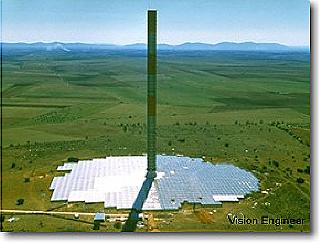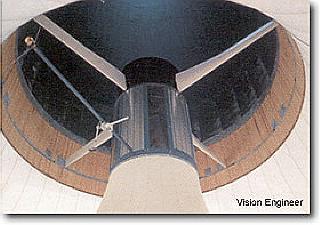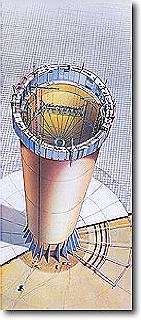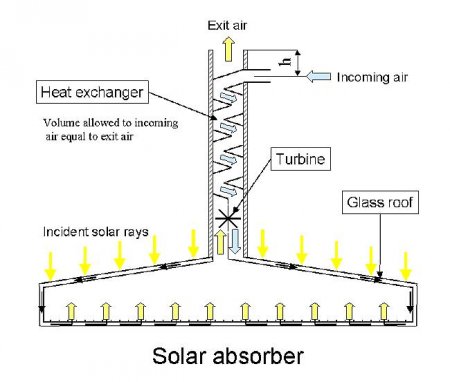-
Centrale aérothermique à cheminée vortex
Creation date: 29th of June. 2012
Solar Chimney Power Station - The Future is Near
Solar flue - Article by : Lawrence Tse
What is a solar flue?
A solar flue is an air stream driven by temperature difference in a solar chimney power station. The solar chimney power stations combine three things in one: the greenhouse, the chimney and the turbine. Air underneath a low circular glass roof open at the circumference is heated by radiation from the sun. The roof and the natural ground below it form a hot air collector ("greenhouse"). A vertical tower tube with large air inlets at its base stands in the centre of the glass roof. The joint between the roof and the tower base is airtight. As hot air is lighter than cold air, it rises up the tower. Suction from the tower then draws in more hot air from the collector, and cold air comes in from the outer perimeter. The energy of the air flow is converted into mechanical energy by pressure-staged wind turbines at the base of the tower, and into electrical energy by electric generators coupled to the turbines.

The Prototype Manzanares Solar Chimney, Spain
A brief history of solar chimney
A prototype solar chimney was built and tested in Manzanares (south of Madrid), by Schlaich Bergermann und Partners, the engineering consultancy founded by Professor Jörg Schlaich. The solar chimney delivered power practically uninterrupted from July 1986 to February 1989 with a peak output of 50 kW. Its collector had a diameter of 240 meters, with surface area of 46,000m2. The chimney was 10 meters in diameter and 195 meters tall.
Potential of solar chimney power station
Solar chimney power stations could make important contributions to the energy supplies in Africa, Asia and Australia, because there is plenty of space and sunlight available there.
Solar chimney power stations are particularly suitable for generating electricity in deserts and sun-rich wasteland.
Their efficiency increases with the height of the chimney, not linearly, but exponentially.
For the power stations to generate electricity economically, not only large glass or plastic roof surfaces are necessary, but also a very high chimney. The height is needed simply from the fact that the updraft is proportional to the height, and also to make best use of the heat available.

La turbine
Advantages of a solar chimney power plant
The advantages of a solar chimney power plant are as follows:
- Electricity production 24 hour a day
It provides electricity 24 hour a day from solar energy alone. At night, heat-absorbing rocks or other heat sources in the "greenhouse" would slowly release the thermal energy built up during the day, maintaining the indoor-outdoor temperature differential. Then the solar chimney can operate around the clock, instead of depending on environmental factors, such as the wind needed for wind farms.
- Free energy
No fuel is needed. It needs no cooling water and is suitable in extreme drying regions.
- Reliable power station
It is particularly reliable and a little trouble-prone compared with other power plants.
- Materials everywhere in sufficient quantities
The materials concrete, glass and steel necessary for the building of solar chimney power stations are everywhere in sufficient quantities.

Construction of a Solar Chimney Power Station is an Engineering Challenge
The 200MW Mildura solar chimney
The 1000m Solar Chimney in Mildura, Australia, will be the highest man-made structure on Earth, and can produce 200MW of electricity, providing power to 200,000 homes. The cost to build the tower is estimated at AUS$ 700 million (US$ 395 million), about 14 percent more than an equivalent coal-fired power station, and about 70 percent more per installed megawatt than a comparable wind farm. However, the investment will pay off in long term because it is more reliable than wind farm in sun-rich Australia and requires no fuel. By building the solar chimney power plant, the Australian government target of producing 2% of energy from renewable sources by 2010 (9500 GigaWatt hours) could be met easily.
Details of the solar chimney are as follows:
- Location: Mildura, Australia
- Type: Solar Tower power plant with steel-reinforced concrete tower and steel/glass solar air collector (alternatively with polymer glazing)
- Features: The base of the tower will be between 170 to 200 metres. The chimney is basically a very simple tube with wall thickness of 25cm, diameter of 150m and a height of 1000m. The collector roof will be 5000m in diameter.
- Power: Up to 500 Gigawatt hours per year
- Company: Enviromission Ltd
- Construction time: About 18-24 months
- Expected completion date: 2005
Further Discussion
Unfortunately, some estimates say that the cost of generating electricity from a solar chimney is 5x more than from a gas turbine. Although fuel is not required, solar chimneys have a very high capital cost. The structure itself is massive and requires a lot of engineering expertise and materials to construct. Is this a viable solution to our every-growing energy needs? Discuss your views in the Visionengineer forums. Turbine for Solar Chimney Power Station Even under very favourable conditions (global solar radiation of 2.5MWh/m2), a 5 MW power station needs a collector roof with 1100m of diameter; a chimney of 445m high and 27m in diameter. To produce 200 MW of power, a 5000m-diameter collector roof as well as a chimney of 1000 m in height and 150 m in diameters are needed. The solar flue reaches a speed of 8m/s if the power plant is under load (the turbine driving the generator to produce electricity). If without load, the solar flue reaches a speed of up to 15m/s. A single Solar Tower power plant with a collector area of 7000m in diameter built and operated in an area with an annual global solar radiation of 2.3 MWh/m2 will generate between 700 and 800 GWh per year. Thus a small number of Solar Tower power plants can even replace a large nuclear power station.
A tower with a tornado tower or pivoting exit at top and solar heated air coming in at the bottom. When the sun is out or the wind is blowing, the air will rise within. By adding a solar jet, the device could produce power if there is sun, wind or if the relative humidity of the air is lower than humidity threshold of the solar jet, probably seventy percent.
From a thermodynamic standpoint, a convection tower can be viewed as a heat engine functioning between a high temperature source and the average of a high temperature sink and a low temperature sink. This is because the gas expansion is continuous until the gas reaches the temperature of the surrounding air. The heat engine is in effect working at a maximum efficiency at the very bottom of the tower and at an efficiency of zero at the top of the tower. Its efficiency is therefore roughly equal to half the temperature difference divided by the temperature of the high temperature source.
A typical solar tower in the desert will have a high temperature source about thirty degrees Kelvin hotter than the low temperature sink. The low temperature sink will be at a temperature of about two hundred and ninety degrees Kelvin, the high temperature source thirty above that at three hundred and twenty degrees Kelvin. For a typical solar tower in the desert:
- Efficiency = 0.5 * temperature difference / high temperature
- Efficiency = 0.5 * 30 K / 320 K
- Efficiency ~= 0.047 * 100 % = 4.7 %
The height of the tower needed to fully convert the thermal energy is roughly equal to the column height of the atmosphere times three and a half because air is mostly a diatomic gas times the temperature difference divided by the temperature of the high temperature source. For a typical solar tower in the desert:
- tower height = column height * 3.5 * temperature difference / high temperature
- tower height = 8516 m * 3.5 * 30 K / 320 K
- tower height = 2794 m
The rate at which the cost of the tower changes relative to the rate at which the height of the tower changes is roughly two and half. In the year 2001, the cost of a one hundred meter tubular steel tower is roughly three million USD. For a typical solar tower in the desert:
- tower cost = 3,000,000 USD * pow( tower height / 100 m, 2.4 )
- tower cost = 3,000,000 USD * pow( 2794 m / 100 m, 2.4 )
- tower cost = 9 billion USD
The tower will have an average minimum diameter about one tenth of its height. Air will be moving through the narrow part of the tower at roughly thirty meters per second. The airflow the tower will handle is equal to the tower area times the airspeed. For a typical solar tower in the desert:
- airflow = pi * radius^2 * airspeed
- airflow = pi * ( 0.5 * tower height / 10 )^2 * airspeed
- airflow = pi * ( 0.5 * 2794 m / 10 )^2 * 30 m / s
- airflow ~= 1,800,000 m^3 / s
The power tapped is equal to its airflow times its density at altitude times its thermal energy per degree times the temperature change per mass times the conversion efficiency. For a typical solar tower in the desert:
- power = airflow * density * thermal energy per degree * temperature change * efficiency
- power = 1,800,000 m^3 / s * 0.56 kg / m^3 * 960 J / K * 30 K * 0.047
- power ~= 1,400,000,000 J / s = 1.4 gigawatts
Assuming that the entire power plant costs twice as much as the tower and that half the power comes from the sun and half from the wind, the cost per watt is equal to the tower cost divided by the power. For a typical solar tower in the desert:
- cost per watt = tower cost * power
- cost per watt = 6.5 USD / W
In 2001, solar panels cost about three dollars per watt in huge quantities, with the extra cost for installation and electrical conversion, the overall cost is about five dollars per watt. It might be possible to lower the cost by using a balloon lifted tower or some other improbable method. Until then, the solar wind tower is basically not worth it; but, it could serve as an imposing monument in video games.
Solar jet
A jet engine using evaporation to cool air in the throat of a venturi. This generates power in a manner similar to evaporation towers which cool air by evaporating water, then let this cool air fall, which can then be tapped with a turbine to obtain mecanical power.
Gas moving through a venturi will speed up in the throat. When it is moving quickly, its pressure will be lower and its temperature will therefore also be lower. At that point, water is injected which as it evaporates cools the air. Since this cooling is being done at a negative relative pressure, work is done, which speeds adds kinetic energy to the air. The air can then be tapped with a turbine to obtain mecanical power or the thrust of a solar jet can be used to propel a vessel.
A solar jet engine with whose throat is small relative to its ends can operate at an outside airspeed of zero, as opposed to a ramjet whose thrust is proportional to the square of the outside airspeed. This is because a cool jet operates at an airspeed in its evaporation chamber which is higher than the outside airspeed, as opposed to a ramjet which operates at an airspeed in its combustion chamber which is lower than the outside airspeed. The operate efficiently, a solar jet should be extremely smooth inside and it should supersature the air with water, ideally by a factor of at least three.
Evaporation changes the temperature of air far less than combustion, so the thermal power available is less. Also, because of the small temperature difference, the efficiency of the heat engine is far less, around five percent instead of the theoretical seventy percent that an ideal combustion engine can achieve. For these reasons, a solar jet will be about four hundred times less powerful than a combustion jet of the same size.
Since evaporation is much slower than combustion, the minimum size of a solar jet has to be much larger than that of a combustion jet. A solar jet has to be about two meters wide to have even a mediocre performance. Smaller jets could be made; but, they would have to supersaturate the air by a proportionately greater factor, so a solar jet one fifth of a meter wide would have to supersaturate the air by a factor of thirty.
Compared to an evaporation tower, a solar jet can be small; however, it needs a threshold amount of dryness in the air to produce net power, so the relative humidity of the air has to probably be lower than seventy percent. Ideally, the air would be heated to a high temperature by solar power, so that it would be in a hot and dry state.
The solar jet is of little use for tapping additional power from air heated by combustion with compounds containing hydrogen, because that air will already be saturated with water vapor. However, it could be used to tap air heated by combustion with carbon.
The solar chimney - would a regenerator improve efficiency?
by Dr Alan Williams - December 2001
The solar chimney offers a method for the large scale generation of electricity from solar energy1.
Ambient air is drawn into the glass collector. This is warmed by solar energy and rises up the chimney. The current of rising warm air drives a turbine. The prototype at Manzanares, Spain worked successfully over several years. There are proposals for the construction of commercial plants of up to 200 MW in India, South Africa, Australia and other countries. The capital cost is high but running costs are very low, the fuel is free and the power station has a long lifetime. The technology could become the cheapest method for the large scale generation of solar electricity.
The overall conversion efficiency from solar energy to electricity is 2-3%. Where does the other 97% go?
- There is a temperature drop with altitude of about 10° C for a 1000 metre chimney2. Large quantities of warm air have to be lifted from the ground to chimney top. This is gravitational energy lost.
- The air that leaves the chimney is above ambient temperature at that altitude. This is thermal energy lost3.
- Ambient air that is drawn into the collector and is warmed expands with little increase in pressure. The majority of solar input is lost in the simple expansion of air before it reaches the turbine. None of this is surrendered to the turbine.
Would a regenerator improve efficiency? The author proposes a modified solar chimney where the paramount consideration is the rigorous elimination of all energy losses. The solar collector is sealed and double glazed with low emissivity glass. The entire floor area has a solar absorber. The chimney is well-insulated and incorporates a heat exchanger along most of its length.

Warm air rises from the solar collector and drives the turbine. Its residual energy is then transferred to incoming air in the heat exchanger – such energy recovery can be over 95% efficient. Incoming air enters well up the chimney at a level ‘h’ from the top, which is needed to drive the system. The incoming air is warmed as it travels down the chimney. It passes through the turbine and then between the two layers of glass to ground level, entering the solar collector from underneath the absorber.
There are no pumps. The chimney is open to the air and at atmospheric pressure. The driver is gravity – air in the collector is warmed by solar energy and rises because it is lighter. This will draw in colder, ambient air which is heavier.
The author claims that the energy losses listed earlier will be dramatically reduced in this proposal:
- The loss of potential energy for the exit air is virtually compensated by the gain in potential energy for the incoming air, except that due to ‘h’.
- The loss in thermal energy for exit air should be dramatically reduced by the regenerator.
- If the regenerator was 100% efficient, then the volume of air entering the chimney per second will equal the volume of air leaving the chimney per second. There will be no net loss due to the expansion of air.
There will be some energy losses through the double glazing, through the walls of the chimney and to gravitation due to the height ‘h’. Any losses in the turbine or due to friction in the heat exchanger will be recycled as heat into the incoming air.
The main energy loss will be in the regenerator and will manifest itself in the exit air having a higher temperature that ambient air at that altitude, a higher velocity and a greater volume than incoming air. The challenge would be to construct a regenerator of ever higher efficiency.
The modifications suggested would perhaps double the capital cost of the solar chimney. It is the author’s assertion, however, that its efficiency will be increased several fold.
References: 1- Schlaich, J., 1995, "The Solar Chimney: Electricity from the Sun". C. Maurer, Geislingen, Germany. 2- Von Backström, T.W. & Gannon, A.J., 2000, "Compressible Flow Through Solar Power Plant Chimneys". ASME Journal of Solar Energy Engineering, Vol. 122, No. 3, pp. 138-145. 3- Padki, M.M. & Sherif, S.A., "On a Simple Analytical Model for Solar Chimneys". International Journal of Energy Research, Vol. 23, No. 4, March 25 1999, pp. 345-349.

